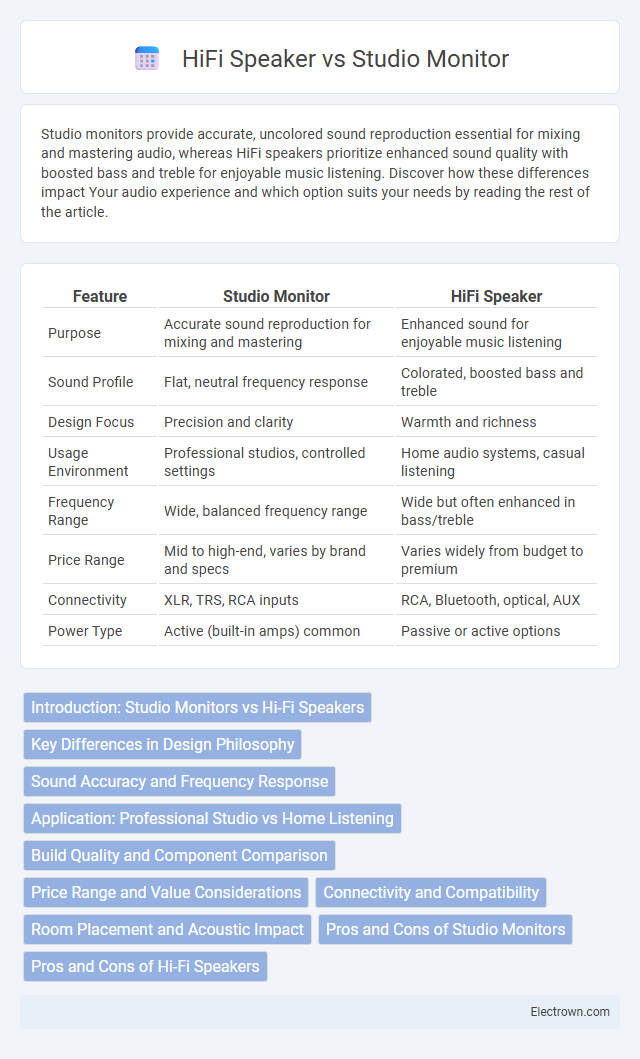Studio monitors provide accurate, uncolored sound reproduction essential for mixing and mastering audio, whereas HiFi speakers prioritize enhanced sound quality with boosted bass and treble for enjoyable music listening. Discover how these differences impact Your audio experience and which option suits your needs by reading the rest of the article.
Table of Comparison
| Feature | Studio Monitor | HiFi Speaker |
|---|---|---|
| Purpose | Accurate sound reproduction for mixing and mastering | Enhanced sound for enjoyable music listening |
| Sound Profile | Flat, neutral frequency response | Colorated, boosted bass and treble |
| Design Focus | Precision and clarity | Warmth and richness |
| Usage Environment | Professional studios, controlled settings | Home audio systems, casual listening |
| Frequency Range | Wide, balanced frequency range | Wide but often enhanced in bass/treble |
| Price Range | Mid to high-end, varies by brand and specs | Varies widely from budget to premium |
| Connectivity | XLR, TRS, RCA inputs | RCA, Bluetooth, optical, AUX |
| Power Type | Active (built-in amps) common | Passive or active options |
Introduction: Studio Monitors vs Hi-Fi Speakers
Studio monitors deliver accurate, uncolored sound designed for critical audio mixing and production, ensuring every detail in your recordings is heard precisely. Hi-Fi speakers prioritize enhanced listening experiences with richer bass and warmer tones, tailored for casual music enjoyment and home entertainment. Choosing between the two depends on whether your primary focus is professional audio accuracy or immersive sound quality for personal use.
Key Differences in Design Philosophy
Studio monitors prioritize accuracy and flat frequency response to ensure precise sound reproduction for mixing and mastering. HiFi speakers emphasize enhanced tonal warmth and coloration to create a pleasing listening experience tailored for casual enjoyment. Design choices in studio monitors often involve minimal distortion and neutral sound, whereas HiFi speakers integrate psychoacoustic enhancements and aesthetic appeal.
Sound Accuracy and Frequency Response
Studio monitors deliver unparalleled sound accuracy with a flat frequency response, ensuring every detail in your audio is reproduced exactly as intended by the sound engineer. HiFi speakers often emphasize enhanced bass and treble to create a more pleasing and enjoyable listening experience, but this can color the original sound. Choosing studio monitors allows you to trust that Your mixes or edits reflect true audio fidelity without artificial enhancement.
Application: Professional Studio vs Home Listening
Studio monitors are engineered for professional studio applications, providing accurate, uncolored sound to help audio engineers make precise mixing decisions. HiFi speakers prioritize a pleasing sound profile tailored for home listening, enhancing musical enjoyment with warmth and bass emphasis. Choosing the right option impacts your audio experience by aligning with whether precision or enjoyment is your primary goal.
Build Quality and Component Comparison
Studio monitors feature robust build quality with components engineered for accuracy and minimal distortion, including high-grade woofers and tweeters designed to deliver precise frequency response. HiFi speakers prioritize aesthetic design and often incorporate materials like wood or metal for enhanced resonance and acoustic warmth, using components that emphasize rich sound reproduction over clinical accuracy. The internal crossovers in studio monitors are typically more sophisticated, ensuring clear separation between frequency bands, whereas HiFi speakers focus on delivering pleasing sound with smoother tonal transitions.
Price Range and Value Considerations
Studio monitors typically range from $150 to $1,000 per unit, offering precise sound reproduction essential for audio production, making them a valuable investment for professional accuracy. HiFi speakers vary widely from $100 to several thousand dollars, often prioritizing aesthetic appeal and room-filling sound, which provides a different kind of value for casual listening enjoyment. Your choice depends on whether accuracy and clarity for mixing or rich, immersive sound for entertainment drives your audio needs.
Connectivity and Compatibility
Studio monitors typically offer balanced XLR and TRS inputs, ensuring low-noise connections ideal for professional audio interfaces and mixing consoles. HiFi speakers often use standard RCA or speaker wire terminals compatible with a wide range of consumer electronics like amplifiers and receivers. Compatibility hinges on the intended use; studio monitors cater to precise audio production setups, whereas HiFi speakers prioritize seamless integration with home entertainment systems.
Room Placement and Acoustic Impact
Studio monitors are designed for accurate sound reproduction with minimal coloration, making precise room placement critical to avoid reflections and standing waves that can distort audio perception. HiFi speakers often emphasize tonal warmth and bass enhancement, allowing for more flexible positioning but requiring careful consideration of room acoustics to maintain sound quality. Proper acoustic treatment and strategic placement enhance the performance of both in various listening environments.
Pros and Cons of Studio Monitors
Studio monitors provide accurate, uncolored sound essential for mixing and mastering audio, offering precise frequency response and flat sound reproduction to identify flaws easily. However, their neutral tonal quality may lack the warmth and engaging sound character that hi-fi speakers provide for casual listening. Studio monitors often require acoustic treatment and proper placement to perform optimally, while hi-fi speakers are designed for optimized listening environments without such strict requirements.
Pros and Cons of Hi-Fi Speakers
Hi-Fi speakers deliver rich, detailed sound tailored for pleasure listening, with a wide frequency response and enhanced bass performance that appeals to audiophiles. They often excel in creating a warm, immersive audio experience but may introduce coloration and lack the flat frequency response crucial for accurate studio monitoring. While perfect for enjoying music in a home setting, Hi-Fi speakers may not provide the precise sound reproduction needed for professional mixing and mastering tasks.
studio monitor vs hifi speaker Infographic

 electrown.com
electrown.com